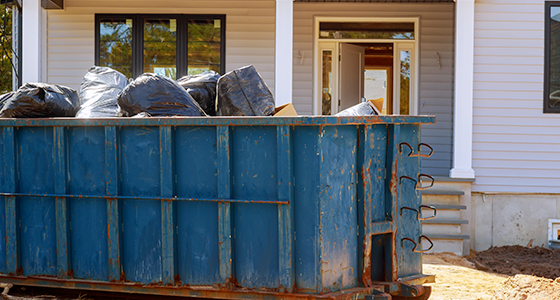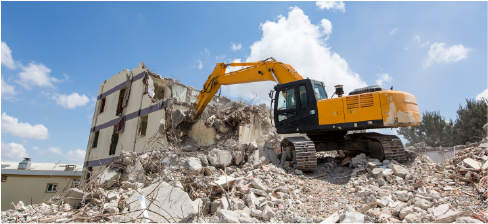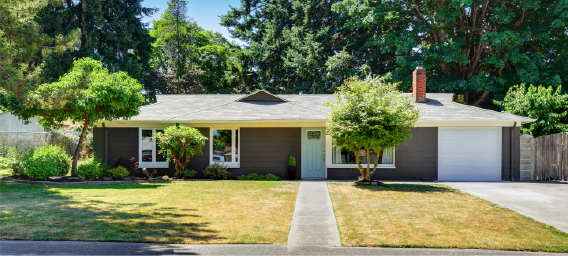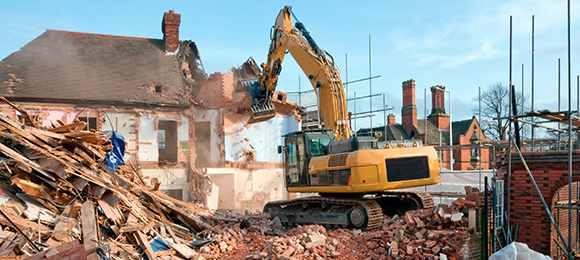
Updated February 2, 2023
House demolition is relatively straightforward and uncomplicated, but that doesn't make it any less intimidating for the first-timer.
If the thought of tearing down a house makes you want to run away screaming, fear not.
Our guide is easy-to-follow and will walk you through the demo process one step at a time, making demolition easy as 1-2-3!
Jump to:
- Choose a Demolition Method
- Find the Right Contractor
- Have the Home Inspected
- Acquire Permits
- Disconnect Utilities
- Ensure the Area Is Safe
- Arrange for Salvage
- Tear Down the House
- Remove Debris
- Prepare for Next Steps
Find house demolition contractors near you
1. Determine the Right Demolition Method for Your Home
There's more than one way to take apart a house, so the #1 on your to-do list is to decide which type of demolition is best for you.
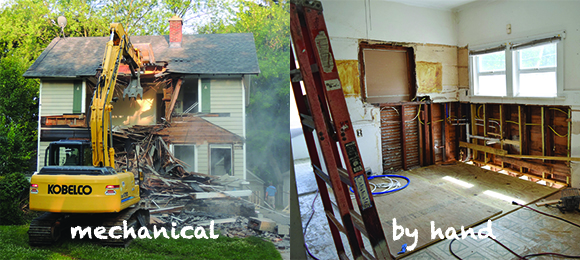
Mechanical Demolition
This is the most common form of demolition—the act of simply tearing down the house with the help of hydraulic excavators and other heavy machinery.
The resulting debris is then hauled away via trailer or dumpster.
Mechanical demolition is the cheapest and fastest solution, costing between $4,000 and $14,000 on average.
Deconstruction
Also known as 'demolition by hand," deconstruction is the process of manually stripping and deconstructing the house piece by piece with the intent of salvaging as many of the materials inside the home as possible.
According to the Environmental Protection Agency, deconstruction projects can recycle or reuse more than 70% of building materials, such as lumber, beams, doors, windows and more.
Because everything is done manually, deconstruction takes much longer and costs significantly more than typical demolition methods—sometimes twice as much.
Interior demolition crews individually take off doors, light fixtures, sinks, tubs, copper pipes, glass from windows...even the nails in the floorboards can be removed and recycled.
Because of the additional labor involved, expect to pay 2 to 3 times as much to deconstruct your home rather than demolish it.
Deconstruction and Demolition
The most highly recommended form of demolition is the combination of deconstruction and demolition.
This includes the act of deconstructing the house first by going through and salvaging a portion of the reusable materials.
Once all desired materials capable of being saved and reused are collected, the remaining structure is then demolished, and remaining debris is hauled away.
This is a great solution for those who want their demo process to be efficient, affordable, and environmentally responsible.
Learn more:
- A Beginner's Guide to Deconstruction
- The Homeowner's Guide to Interior Demolition
- Kitchen Remodeling 101: Costs, Safety, and How to Get Started
- Most Valuable Home Improvement Projects
2. Hire the Right Demolition Contractor for the Job
Find a licensed and insured demolition contractor to help you choose the best way to wreck and remove your house.
They will meet you at the site and go over possible solutions. As demolition experts, they'll be able to thoroughly discuss your options.
Get proposals or estimates in writing, and be sure the contractor's estimate spells out whose responsibility it is to pay for and pull permits (if required) for the work.
Learn more about hiring the right contractor:
- 7 Keys to Successfully Hiring a Demolition Contractor
- Avoid These 5 Red Flags When Hiring a Contractor
- 2 Jobs, 1 Contractor: How to Save Money on Demolition Projects
- Licensing 101: A State-by-State Guide to Contractor License Requirements
3. Have the House Inspected by a Professional
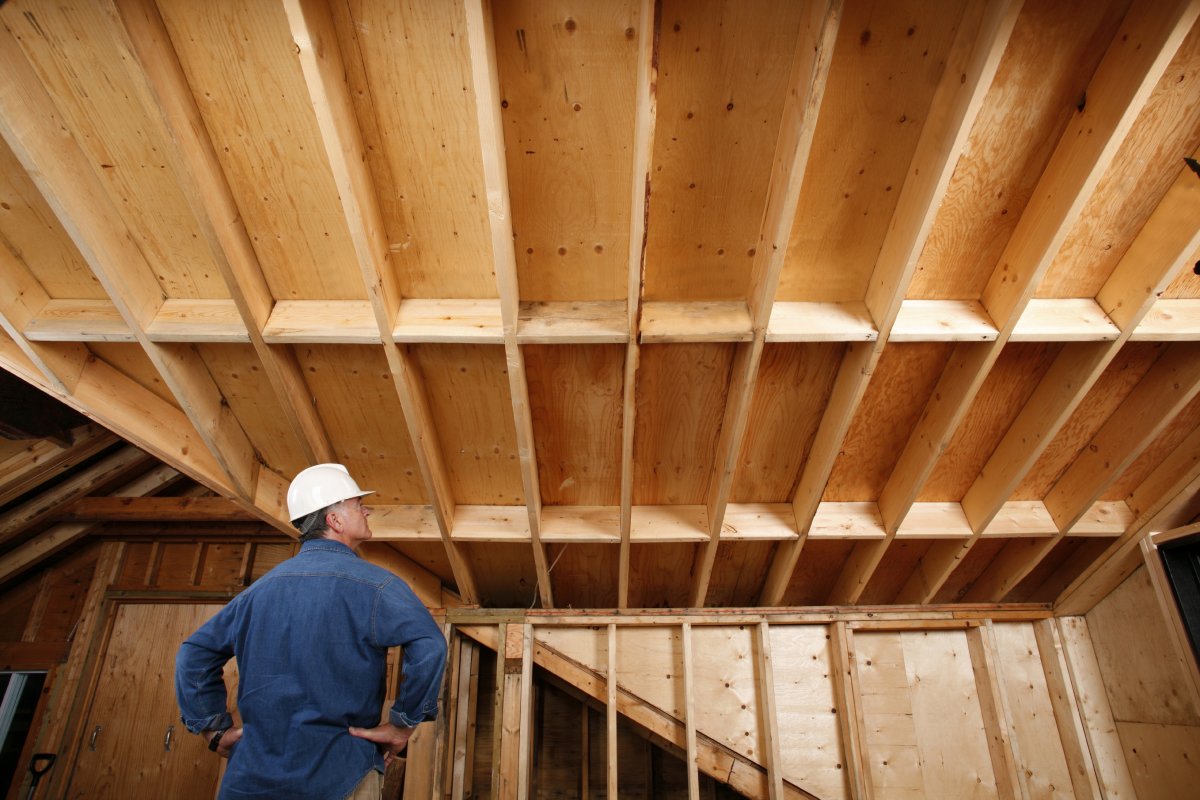
Ask your building demolition contractor what the inspection requirements in your area are.
Most states require that older homes/buildings be inspected prior to demolition for the presence of:
- Asbestos
- Lead paint
- Mold
- Rotted wood
- Other hazardous materials
If the home contains asbestos or lead paint, proper procedures for remediation need to be followed.
The demolition company you hire may offer this service or sub-contract it to an environmental specialist.
Here's an example of the items looked at during a total home inspection. Look it over to get a better idea of what these inspections cover.
Find a house demolition contractor near you
4. Get the Necessary Permits
A permit will typically need to be pulled prior to starting the demolition.
Permits are typically available at your local City Hall; check your city's government website for more information. The exact permit(s) necessary will depend on your local and state laws and regulations.
Your city or county government may also have rules for house demolition related to:
- notifications
- noise
- hours of demolition
- disposal of the debris, etc
The demolition company you hire should be well informed about local regulations and will pull the permits on your behalf in most cases.
Be sure to clarify up front with the contractor all the services they will perform, including whether or not they will be pulling and paying for the permits required. Ask as many questions as needed, but make sure you ask these 13 questions to make sure you avoid contractor scams.
5. Disconnect Existing Utility Services
There are a variety of utilities and services that must be disconnected before demolition:
- electricity
- water
- sewage
- gas
BEWARE: Electricity and gas pose a particularly dangerous health risk if still active when demolition takes place.
Surrounding supply sources can also be damaged if services have not been properly terminated. Neighboring homes can be at risk of losing services, and local power, gas, water, or drainage infrastructure can be affected, too.
Make note: Most service termination requests need to be made in writing to the supply company two or more weeks prior to demolition. This will help ensure the company has enough time to terminate the service before demolition begins.
6. Ensure the Area Is Safe for Others

In addition to shutting off utilities, make sure adjacent buildings and walkways are protected by putting up debris-containing temporary fencing, like the kinds shown above.
Helpful Hint: It also doesn't hurt to have a conversation with your neighbors before the mess and noise start up. Let them know of the work being done. Having the patience of your neighbors will only make the demolition process easier.
7. Arrange for Salvage
If you have any salvageable materials in the home, work with your contractor to recover recyclable or reusable materials that can be resold or donated.
There are several organizations and charities that can assist in the deconstruction of a house, often times free of charge.
Many local sectors of Habitat for Humanity have deconstruction programs in which professional teams come to your house and do the deconstructing for you.
Going this route can save you both time and money. Not only does it help keep materials out of the landfill while also supporting Habitat's Homeownership Program, but it's also tax-deductible and saves in demolition costs.
8. Tear Down the House
This can take anywhere from one day to several days. Home demolition generally involves a large, hydraulic excavator tearing down the house and putting the unwanted house materials into the back of a truck or dumpster.
However, if are choosing to go the route of deconstruction—whether partial or complete—this process can take much longer.
Find a house demolition contractor near you
9. Remove All the Debris
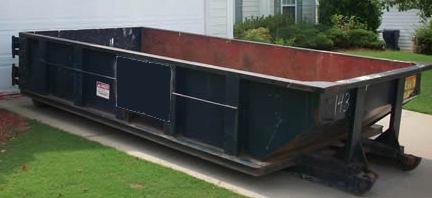
Remove all demolition debris from the site, leaving the site clean. Typically, this means the removal of everything 'down to the dirt," including removal of the house's foundation.
Learn more about proper debris disposal:
- Debris Removal: The Complete Guide to Getting Rid of Anything
- 7 Easy Ways to Get a Discount on Dumpster Rental
- How Much Does It Cost to Rent a Dumpster for a Week?
- The Big List of Dumpster Rental Costs in All 50 States
10. Prepare for What's Next
If you're rebuilding on the same site, your demolition contractor can oftentimes use much of the same heavy equipment to prepare your site for the new house, whether grading or basement excavation is needed.
Money Saving Tip: If you're planning on rebuilding in the same spot, using your demolition contractor for your excavation can save you time and money.
Learn more about planning your project:
